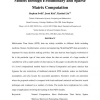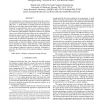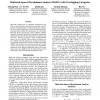662 search results - page 71 / 133 » Making inferences with small numbers of training sets |
NC
2006
13 years 8 months ago
2006
Multivariate Time Series (MTS) data are widely available in different fields including medicine, finance, bioinformatics, science and engineering. Modelling MTS data accurately is...
ICASSP
2008
IEEE
14 years 3 months ago
2008
IEEE
The emerging theory of compressed sensing (CS) provides a universal signal detection approach for sparse signals at sub-Nyquist sampling rates. A small number of random projection...
MLDM
2007
Springer
14 years 3 months ago
2007
Springer
Support vector machine (SVM) has received much attention in feature selection recently because of its ability to incorporate kernels to discover nonlinear dependencies between feat...
AAAI
2010
13 years 9 months ago
2010
Multi-task learning aims at combining information across tasks to boost prediction performance, especially when the number of training samples is small and the number of predictor...
TNN
2010
13 years 3 months ago
2010
Abstract--A crucial issue in designing learning machines is to select the correct model parameters. When the number of available samples is small, theoretical sample-based generali...



